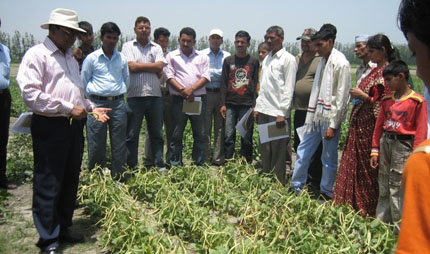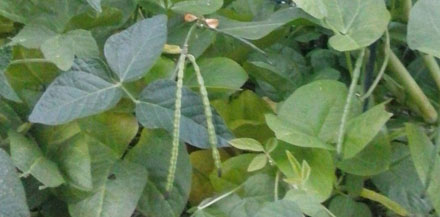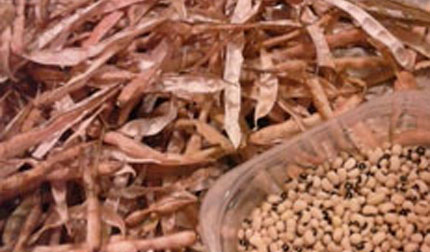Soil Science Society of America
5585 Guilford Road • Madison, WI 53711-5801 • 608-273-8080 • Fax 608-273-2021
www.soils.org
Twitter | Facebook
NEWS RELEASE
Contact: Hanna Jeske, Associate Director of Marketing and Brand Strategy, 608-268-3972, hjeske@sciencesocieties.org
Cowpeas are the answer. What’s the question?
Aug. 31, 2016 - Available cropland, and the growing season, is limited. Strained soils are in need of rejuvenation. Water can be scarce. Yet the world’s nutritional needs continue to grow, along with its population.

Enter the cowpea. A modest but versatile crop, cowpeas may provide an answer to demands on grower resources—and international appetites.
“With so many useful traits including 60-day maturity, cowpeas are becoming an increasingly important legume,” researcher B.B. Singh asserts. “They complement other crops and ensure higher food production and family nutrition, without competing for land and other resources.”
Although contributing to agricultural science since the 1960s, Singh began focusing on cowpeas, also known as black-eyed peas, in 1979. Then, as now, popular crops of corn, wheat, and rice provided calorie-dense food. Their nutrition profiles, however, are limited. Cowpeas, with up to 30% protein and a strong following in diets across the globe, were ripe for development.
Just as important, cowpeas can fill the short growing time between other crops. Singh has developed over 100 varieties that fit into a tight 60 days, seed-to-harvest. Other crops can need twice as much growing time. This allows farmers to rotate cowpeas between other crops to maximize land, labor, and other resource use.
Niche performance is only one reason global production of cowpeas has increased 70% over a decade. The rising popularity is also testament to an ability to grow in challenging, heat- and drought-ridden conditions. Cowpeas grow anywhere with two months of temperatures between 59-104°F. Cowpeas are also shade tolerant, making them a good choice for growth alongside taller crops.
Fu rther, they maximize the soil’s work while increasing soil health. It seems counterintuitive for a field to work harder and be healthier. However, cowpeas pull valued nitrogen out of the air for use in the root zone. Because part of this nitrogen, vital for all crop growth, remains in the soil, farmers can use less fertilizer for the next crop and come out with higher yields. Cowpeas’ roots also access phosphorus that may be limited in the soil. And, their quick growth and rapid ground cover prevent soil erosion.
rther, they maximize the soil’s work while increasing soil health. It seems counterintuitive for a field to work harder and be healthier. However, cowpeas pull valued nitrogen out of the air for use in the root zone. Because part of this nitrogen, vital for all crop growth, remains in the soil, farmers can use less fertilizer for the next crop and come out with higher yields. Cowpeas’ roots also access phosphorus that may be limited in the soil. And, their quick growth and rapid ground cover prevent soil erosion.
Squeezing in this extra crop also benefits farming families. Farmers can sell the results of a cowpea planting twice: First the cowpea itself, and then the residue left in the field. This residue is a high-protein food source for livestock, meaning better weight gain and higher milk yields.
Singh defines the benefits of pulses in very tangible and personal ways. “In Nigeria, the extra income broke the poverty cycle for many farmers in two years, increased their purchasing power, and supported the schooling and health care of their children. Farmers are able to make efficient use of their land, machinery, and other resources during the period no other crop can be grown.”
Cowpeas also show promise in reducing world hunger and malnutrition. As an affordable source of protein, cowpeas go a long way to provide a major part of the recommended 50-70 grams of protein per person per day. “In Northern India alone, with 10 million hectares in wheat-rice rotations, cowpeas as a niche crop could produce between 10 and 15 million tons of cowpeas. That would double the availability of cowpeas to all people in India to 60 grams per day.”

Singh praises cowpeas’ nutritional package for all. Loaded with protein, fiber, iron, zinc, calcium, and antioxidants, cowpeas are a valued addition to any diet. In addition, their food contribution goes beyond use of the dried seeds. The leaves are similar to spinach. The immature green pods are also edible.
Singh presented his work with cowpeas at the 2015 Annual Meeting of the Crop Science Society. The proceedings can be accessed here. Singh’s book, Cowpea: The Food Legume of the 21st Century, supports cowpeas’ place in global agriculture and in every diet. It is available online.
Dried beans such as cowpeas are part of a food group known as pulses. The United Nations Food and Agriculture Organization declared 2016 the International Year of Pulses (IYP). In celebration, the Crop Science Society of America (CSSA) created a web page for the public about pulses, www.crops.org/iyp. Special tabs for the public include K-12 Education, Beans in the News, Grown Your Own, and Delicious Ideas.
CSSA will release more information about pulses throughout the 2016 IYP celebration.